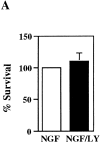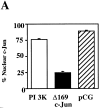Activated phosphatidylinositol 3-kinase and Akt kinase promote survival of superior cervical neurons
- PMID: 9348296
- PMCID: PMC2141707
- DOI: 10.1083/jcb.139.3.809
Activated phosphatidylinositol 3-kinase and Akt kinase promote survival of superior cervical neurons
Abstract
The signaling pathways that mediate the ability of NGF to support survival of dependent neurons are not yet completely clear. However previous work has shown that the c-Jun pathway is activated after NGF withdrawal, and blocking this pathway blocks neuronal cell death. In this paper we show that over-expression in sympathetic neurons of phosphatidylinositol (PI) 3-kinase or its downstream effector Akt kinase blocks cell death after NGF withdrawal, in spite of the fact that the c-Jun pathway is activated. Yet, neither the PI 3-kinase inhibitor LY294002 nor a dominant negative PI 3-kinase cause sympathetic neurons to die if they are maintained in NGF. Thus, although NGF may regulate multiple pathways involved in neuronal survival, stimulation of the PI 3-kinase pathway is sufficient to allow cells to survive in the absence of this factor.
Figures










References
-
- Ahmed NN, Franke TF, Bellacosa A, Datta K, Gonzalez-Portal ME, Taguchi T, Testa JR, Tsichlis PN. The proteins encoded by c-akt and v-akt differ in post-translational modification, subcellular localization and oncogenic potential. Oncogene. 1993;8:1957–1963. - PubMed
-
- Bellacosa A, Testa JR, Staal SP, Tsichlis PN. A retroviral oncogene, akt, encoding a serine-threonine kinase containing an SH2-like region. Science (Wash DC) 1991;254:274–277. - PubMed
-
- Borasio GD, John J, Wittinghofer A, Barde YA, Sendtner M, Heumann R. ras p21 protein promotes survival and fiber outgrowth of cultured embryonic neurons. Neuron. 1989;2:1087–1096. - PubMed
-
- Burgering BM, Coffer PJ. Protein kinase B (c-Akt) in phosphatidylinositol-3-OH kinase signal transduction. Nature (Lond) 1995;376:599–602. - PubMed
MeSH terms
Substances
LinkOut - more resources
Full Text Sources
Other Literature Sources
Molecular Biology Databases
Research Materials
Miscellaneous

